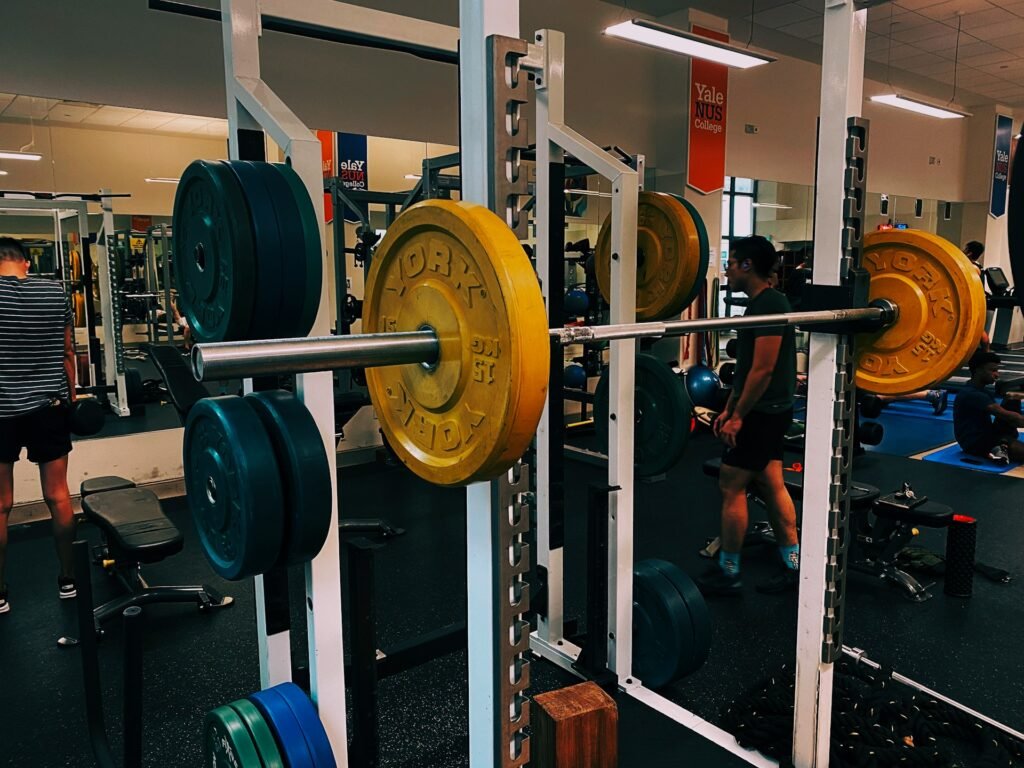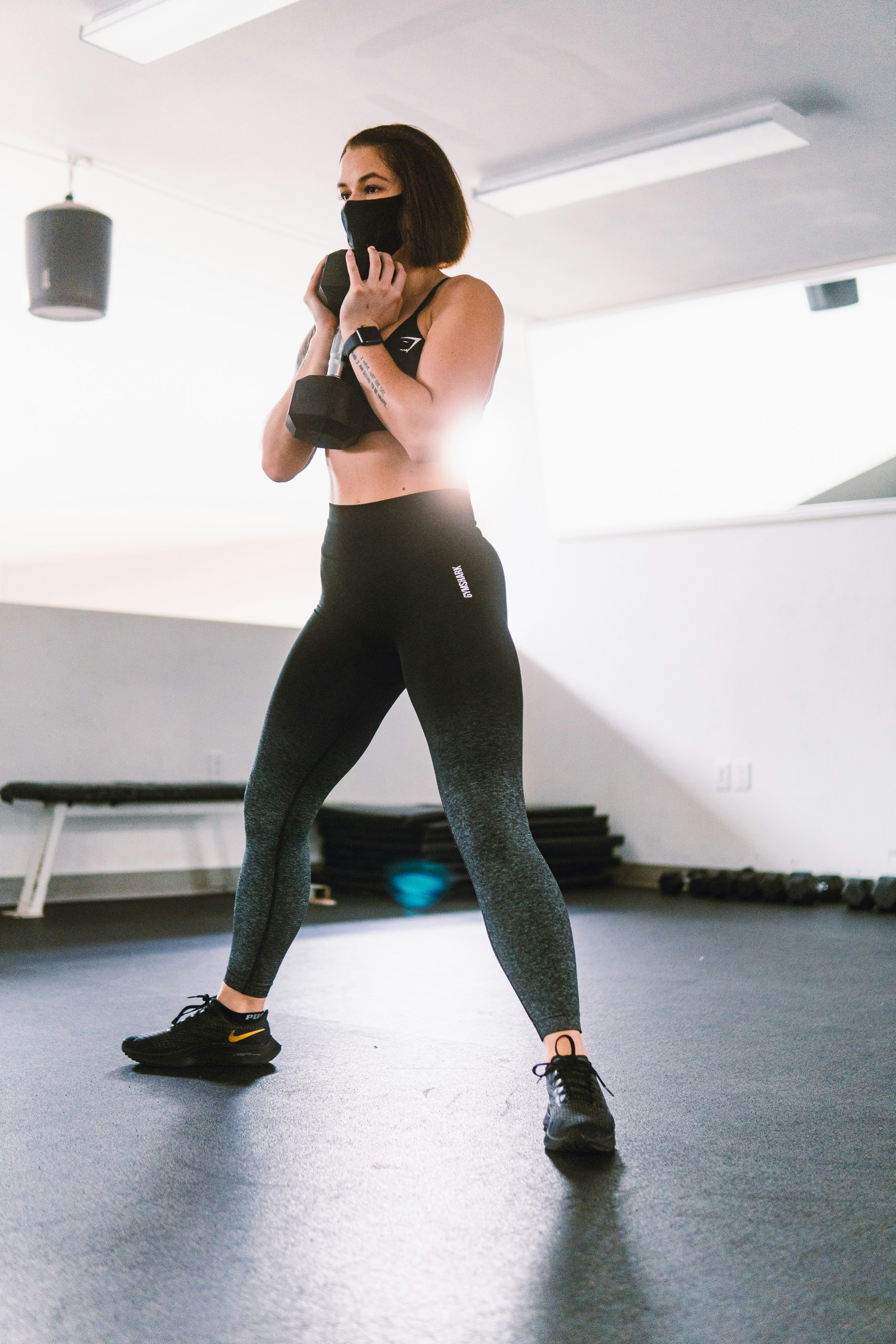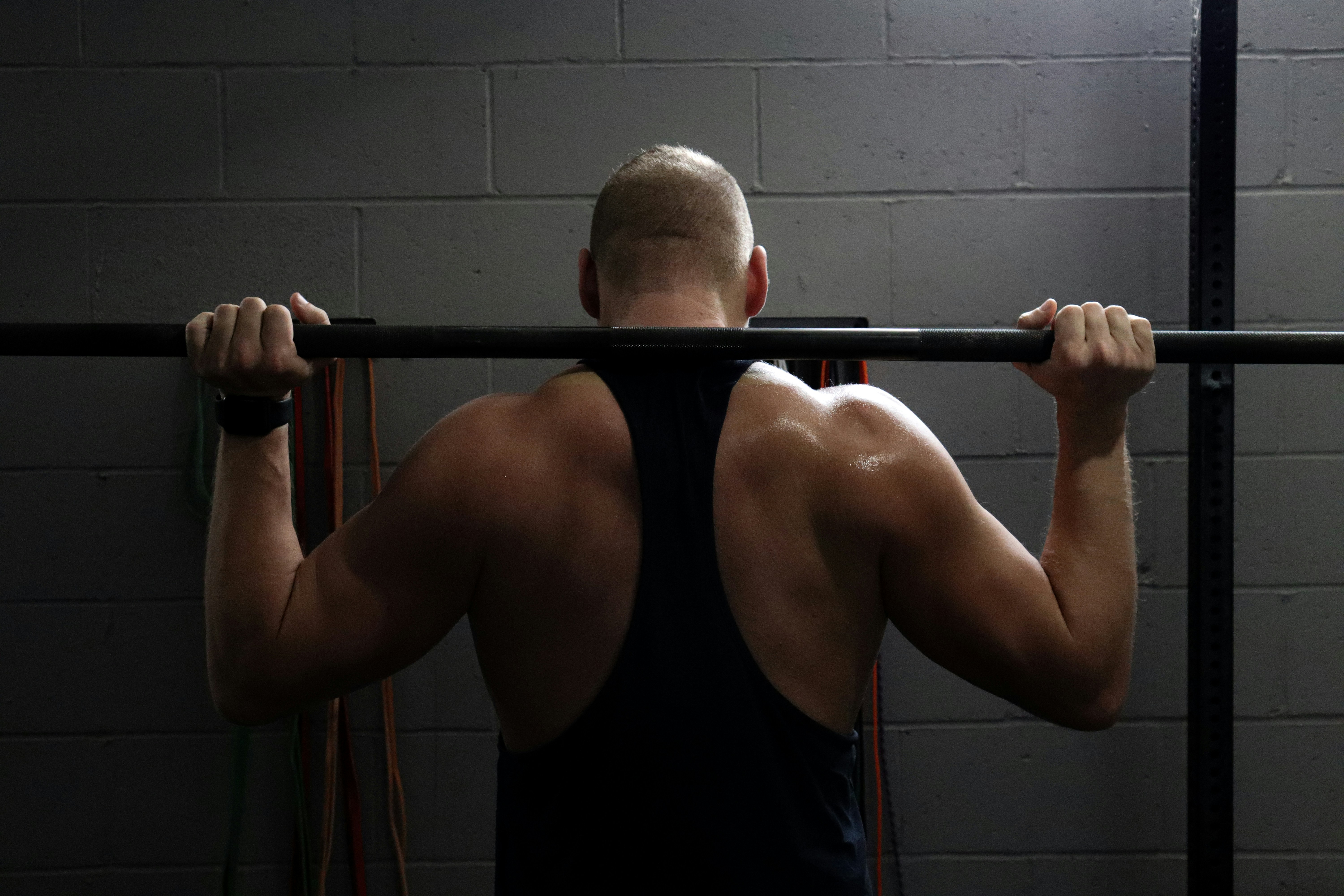
Photo by Keith Yap on Unsplash
The goblet squat and the barbell squat are essential exercises in any weightlifting routine, each offering unique advantages. Both exercises primarily target the lower body, including the quads, hamstrings, and glutes. However, they also require core engagement and stability, making them effective full-body workouts. Understanding their differences and benefits can help you decide which one to prioritize based on your fitness goals and experience level.
The goblet squat is performed by holding a dumbbell or kettlebell close to your chest, making it a valuable tool for beginners who need to learn proper squat form. This variation helps improve balance and stability while reinforcing proper squat mechanics. Additionally, goblet squats are great for movement preparation, making them a perfect warm-up exercise before more complex lifts like the barbell squat. Goblet squats are often praised for their lower risk of injury and easier learning curve, especially for those new to weightlifting [source].
On the other hand, the barbell squat is a staple in strength training programs, offering unmatched benefits for building muscle mass and strength. This exercise requires placing a barbell across your upper back (back squat) or shoulders (front squat), demanding more from your posterior chain and core. Research indicates that barbell squats are highly effective for increasing maximal strength, making them indispensable for athletes and serious lifters aiming for significant muscle hypertrophy. Barbell squats are also crucial for sports performance, especially in disciplines like powerlifting and Olympic weightlifting [source].
Both squats have their place in a well-rounded fitness regimen. For more exercise options targeting the lower body, check out our Barbell Leg Workout for additional variations and tips.
Understanding the roles and benefits of goblet squats and barbell squats can guide you in structuring an effective workout plan tailored to your specific needs and goals.
Muscle Hypertrophy: Goblet Squat vs Barbell Squat
Muscle growth, or hypertrophy, occurs mainly through increased training volume, time under tension, and adequate loading. Both goblet squats and barbell squats can contribute to hypertrophy, but their effectiveness differs based on these principles.
The barbell squat stands out for promoting muscle hypertrophy due to its potential for higher loading. Most lifters can lift heavier with a barbell than with a dumbbell, thereby creating more significant muscular adaptations. For effective muscle growth, experts suggest working at 50-75% of your one-rep max (maximal load capacity) for 12-16 total sets per week, with each set consisting of 6-12 repetitions.
Goblet squats are particularly useful for beginners, as these help in mastering squat form and building initial muscle strength. However, for experienced lifters, goblet squats likely won’t provide enough load to stimulate significant hypertrophy compared to barbell squats. They’re often used more effectively as part of a warm-up, movement preparation, or for finishing sets.
A study on muscle activation highlighted that barbell squats activate more muscle fibers in the quadriceps and glutes due to the higher weights involved and broader range of motion (BarBend, 2023).
In summary, while goblet squats offer several benefits for form training and moderate muscle engagement, barbell squats remain the go-to for maximizing muscle hypertrophy due to their capacity for heavier loads and increased mechanical tension.
For more on effective leg workouts, check out our guide on barbell leg workouts.
Strength Development: Which is More Effective?

Photo by Matthew Sichkaruk on Unsplash
When it comes to building strength, both goblet squats and barbell squats offer unique benefits, but they vary significantly in effectiveness based on certain criteria and training goals.
Goblet Squat: This exercise is highly beneficial for beginners and those focusing on form. Holding the weight in front of you helps maintain an upright torso, reducing the risk of lower back injuries. The goblet squat also serves as an excellent tool for teaching and reinforcing proper squat mechanics. However, the limitation comes in the form of load capacity. Most people will find it challenging to progress to the heavier weights needed for maximal strength gains as the load is limited by what they can hold comfortably in front of them.
Barbell Squat: In contrast, the barbell squat is often considered the gold standard for strength development. It allows for much heavier loading, which is essential for significant strength gains. A study in the Journal of Strength and Conditioning Research found that participants who engaged in regular barbell squats saw a more substantial increase in maximal strength compared to those who performed other forms of squat exercises Schoenfeld et al., 2017. The back squat, in particular, engages multiple muscle groups including the glutes, hamstrings, quadriceps, and lower back, making it a comprehensive exercise for overall strength.
Conclusion: While goblet squats are great for teaching form and providing a moderate stimulus for muscle endurance and hypertrophy, the barbell squat stands out as the more effective exercise for maximal strength development. For those looking to build serious strength, incorporating barbell squats into their routine is essential.
For more insights on integrating effective cardio routines with strength training, you might find our article on steady-state cardio examples useful. This can help you balance your strength and endurance training optimally.
Injury Prevention and Rehabilitation
Injury prevention and rehabilitation are essential aspects of any fitness routine, especially when performing complex exercises like goblet squats and barbell squats. These squats engage various muscles, including the quadriceps, hamstrings, and glutes, making them potent for both strength gains and injury risks if not done correctly.
Preventing Injuries: To mitigate injury risks, it’s critical to maintain proper form. Studies show that incorrect squatting technique is a primary cause of injuries in the lower back and knees (Intulo Health Blog, 2022). Wearing proper footwear, warming up, and gradually increasing weights can also help prevent injuries. According to the American Council on Exercise, including mobility and stretching exercises in your routine can reduce the likelihood of injuries by up to 50%.
Rehabilitation: Should you experience an injury, rehabilitation becomes crucial. Rehabilitation aims to restore strength, flexibility, and stability. Techniques such as sports massage, mobilization, and deep tissue massage can significantly expedite recovery (Intulo Health Blog, 2022). Rehabilitation programs tailored to individual needs are essential for effective recovery, as each person’s body and injury differ.
For those new to squatting or recovering from an injury, starting with goblet squats can be beneficial due to their lower risk profile compared to barbell squats. You can learn more about strength exercises and their benefits in this article.
For further details on injury prevention through proper rehabilitation techniques, check the comprehensive guide from Intulo Health here.
By prioritizing injury prevention and following customized rehabilitation programs, you can maintain a safe and effective fitness regimen.
Squat Variations for Different Fitness Goals

Photo by Morrow Solutions on Unsplash
Squats are highly adaptable, making them an essential exercise for various fitness objectives. Depending on whether you’re targeting strength, hypertrophy, or endurance, there are squat variations to meet your goals.
1. Strength Building:
For increasing strength, barbell back squats are a solid choice. They engage multiple muscle groups, including quads, hamstrings, and glutes, and allow you to lift heavy weights safely. According to research, back squats are particularly effective for lifting significant loads [source].
- Barbell Back Squat: Aim for 3-5 sets of 1-6 reps with heavy weights.
- Bulgarian Split Squat: Benefits muscle imbalances; 3-4 sets of 8-10 reps per leg.
2. Muscle Hypertrophy:
To build muscle mass, opt for variations that maintain tension on the muscles through the full range of motion. Goblet squats and front squats are ideal as they keep the core engaged, helping develop both leg and core strength simultaneously.
- Goblet Squat: 3-4 sets of 8-12 reps. Holding a weight in front aids in maintaining form.
- Front Squat: 3-4 sets of 6-10 reps. Targets quads more intensely due to the front-loading of the weight.
3. Endurance and Functional Training:
For enhancing muscular endurance and functional strength, bodyweight squats and high-rep barbell squats are excellent. These variations improve stamina and can be integrated into cardio routines for a full-body workout.
- Bodyweight Squats: For beginners or those focusing on technique, sets of 15-20 reps.
- Sumo Squats: Engages inner thighs and glutes, making it versatile for functional training.
One key aspect is the versatility offered by squats. Regardless of your fitness level, from novice to advanced, integrating various squat styles into your routine helps in building a balanced physique [source].
For tips on incorporating these squats with other exercises to achieve holistic training, you can explore this article on barbell leg workouts.
By selecting the appropriate squat variation for your fitness goals, you can effectively advance your strength, build muscle mass, or improve endurance.
General Fitness and Functional Training
Functional training aims to improve daily activities by enhancing the movements needed in everyday life, such as walking, bending, and lifting. Research shows that functional training can enhance balance, flexibility, and stability, which are vital for daily tasks. According to a study published in the International Journal of Sports Physical Therapy, although there was no significant difference between conventional strength training and functional training overall, women showed less improvement in functional capacity when participating in functional training compared to men (Pacheco et al., 2013).
General fitness, on the other hand, focuses on improving overall health and well-being. This includes a mix of cardiovascular exercises, strength training, and flexibility exercises. For instance, mixing in barbell squats or goblet squats can contribute greatly to both muscle strength and functional performance. The importance of squats in fitness regimes can also be seen in their variations, such as goblet squats, which particularly engage core muscles, aiding in functional improvement.
Both functional and general fitness training have their own advantages. Integrating both can offer a balanced approach to strength and mobility. Whether your goal is to enhance everyday tasks or improve overall health, exercises like squats can serve multiple purposes.
If you’re interested in diving deeper into different types of cardio and their benefits, check our overview of steady-state cardio.
Conclusion and Recommendations
When considering whether to prioritize goblet squats or barbell squats, the decision ultimately depends on your specific fitness goals and current level of experience.
Goblet Squats are often recommended for beginners or those looking to improve their form. They are easier to learn and require less equipment. Additionally, they place less stress on the lower back, making them a good option for injury prevention and rehabilitation. A study published in the Journal of Strength and Conditioning Research found that goblet squats effectively activate the quadriceps and glute muscles, which can be particularly beneficial for those new to strength training [source].
Barbell Squats, on the other hand, are typically preferred by more advanced lifters. They allow for greater load and therefore can lead to significant strength and hypertrophy gains. According to data from the National Strength and Conditioning Association, barbell squats can increase lower body strength by 30% more than goblet squats in trained individuals [source]. However, they require proper technique to avoid injury, particularly to the lower back and knees.
Recommendations:
- Beginners: Start with goblet squats to build foundational strength and master the squatting form. As you become more comfortable, consider incorporating barbell squats to your routine for increased strength gains.
- Intermediate to Advanced Lifters: Prioritize barbell squats for their efficiency in building strength and muscle mass. However, do not completely discard goblet squats as they can be an excellent warm-up exercise or a lighter alternative on recovery days.
- Injury Prevention: If you are recovering from an injury or have issues with your lower back, prioritize goblet squats. They are less taxing and can help you maintain strength without risking further injury.
For a more comprehensive understanding of choosing the right exercises based on your goals, you might find our article on barbell leg workouts insightful.
Remember, the best squat variation is the one that aligns with your fitness objectives, experience level, and ensures safety during your workouts.